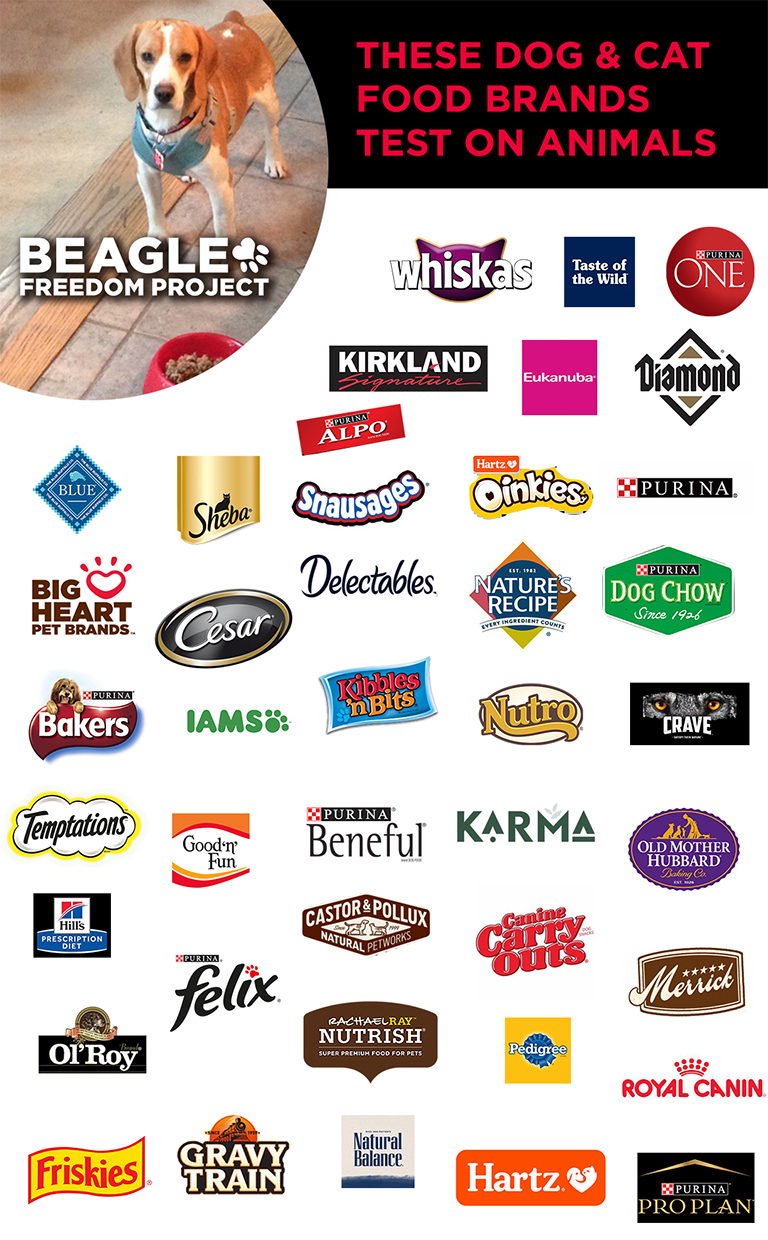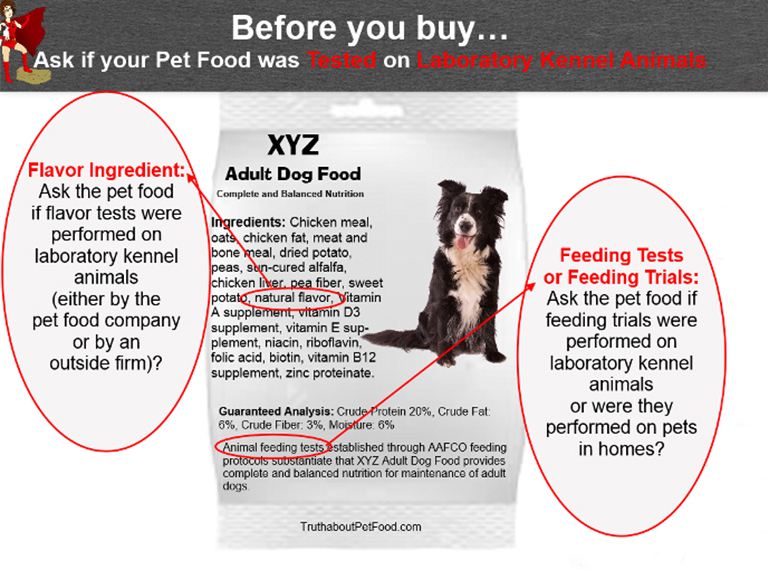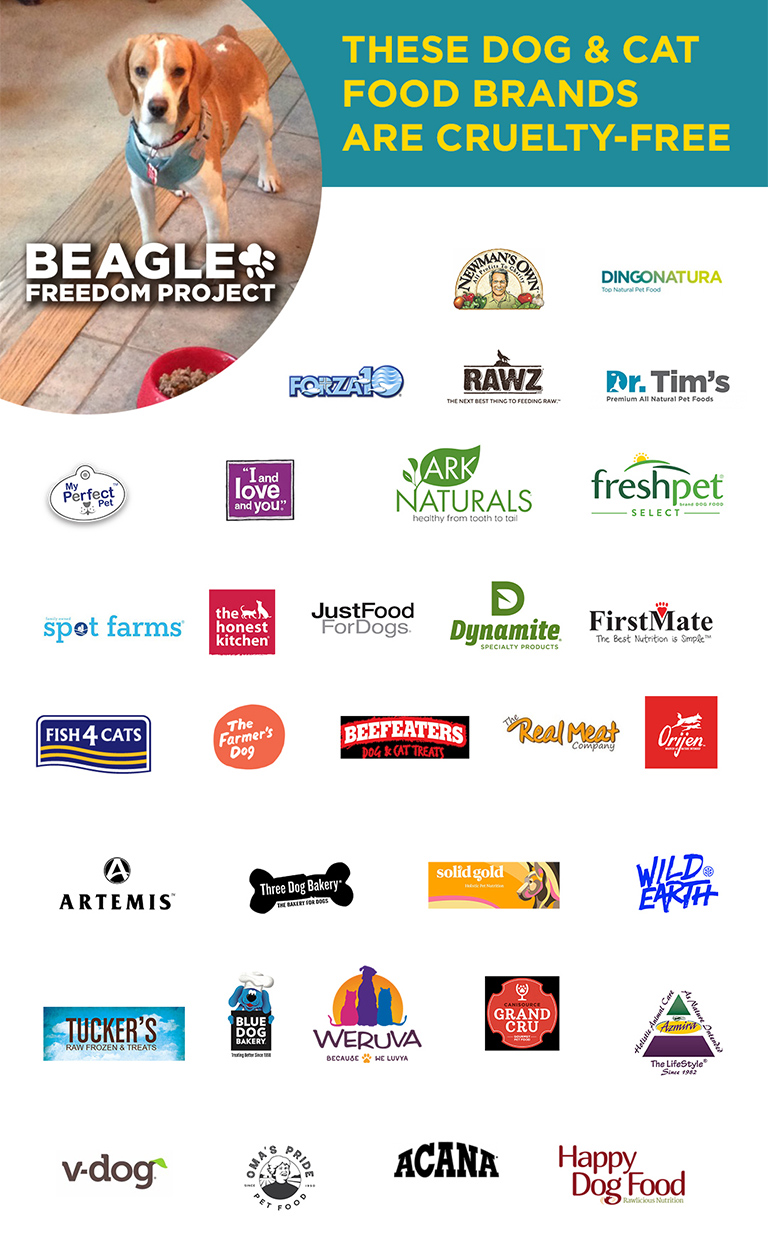When Pet Foods Lie
PETA's 11-month undercover investigation into an Iams contract research lab exposes animals in dire distress and pain.1 Experiments on companion animals are not legally required to sell pet food. PETA's findings draw backlash when the public learns about this secretive practice.
- Brands that feed test and/or test ingredients on cats, dogs, other species in labs:
- Mars: Iams, Eukanuba, Pedigree, Whiskas, Catsan, Cesar, Chappie, Crave, Dreamies, Greenies, Nutro, Orijen, Sheba
- Royal Canin (subsidiary of Mars): Non-script and prescription Royal Canin pet foods
- Colgate-Palmolive: Hill's Science Diet, Hill's Prescription Diet
- Nestlé: Purina (all lines), Friskies, Bakers Complete, ProPlan, Fancy Feast, Felix, DentaLife
- Big Heart Pet Brands: Meow Mix, Milk-Bone, Kibbles n’ Bits, 9Lives, Pup-Peroni, Gravy Train, Nature's Recipe, Canine Carry Outs, Milo's Kitchen
- Canidae, Natural Balance
- Blue Buffalo (General Mills)
- And more brands: Before you buy, ask if your food was tested on lab kennel animals.
- Beagle Freedom Project: Lucky Ones, Saved After Years In A Lab
The promise of kibble. Certified goodness in a can. You go to great lengths to buy the best for your kids with fur. But a dark secret hides behind guaranteed counts for protein, fat, moisture, vitamins… Many pet food brands conduct tests on companion animals. The Iams Company becomes a historical marker for in vivo (on living beings) research after a People For The Ethical Treatment Of Animals (PETA) 2000-2004 investigation reveals horrific experiments. Animals are purposefully bred to languish in labs, caged on hard floors, mishandled, needle-jabbed… They suffer invasive tests and surgeries before killed. Which companies still fund brutal tests on cats and dogs? Hard to tell. Many claim to run gentler tests in enriched lab settings, plus study animals at veterinary practices or in pet homes. So who lab tests? Follow the money. Search a big line, such as Nestlé Purina PetCare in National Institutes Of Health (NIH) Library Of Medicine. You'll often find who funds labs, buried in disclaimers. For example, a 2023 study — Reproduction of Domestic Cats in Laboratories, Catteries, and Feral Colonies: A Review — lists numerous sponsors:
Conflict Of Interest Statement: AJF (Andrea J Fascetti) has advised Synergy Food Ingredients and Clorox, and has a grant from Nutro. A resident received funds through Hill's Pet Nutrition Resident Clinical Study Grants; AJF has received remuneration for lectures, or as an advisor for Nestlé Purina PetCare, Mars Petcare, Hill's Pet Nutrition, Purina Institute, Mark Morris Institute, and Pet Food Institute. AJF had an FDA contract to collect control dog urine and measure amino acid concentrations. AJF receives support from Nestlé Purina PetCare, Hill's Pet Care, and Mars Petcare. JAL (Jennifer A Larsen) is an investigator in research sponsored by Royal Canin, Nature's Variety Instinct, and Nestlé Purina PetCare…2
For 9 months a PETA spy works inside an Iams-sponsored laboratory. At the time, Iams employs over 30 contract labs and university research centers to conduct off-site animal testing. PETA's 2002-2003 undercover probe at Sinclair Research Center, a U.S. lab under contract for Iams, exposes inconceivable animal suffering. Some 27 dogs are killed for experimentation. Others die from artificially induced disease or lack of care. Meanwhile, Iams promises the public that no animal is harmed or killed in tests. But footage and records inside Iams-funded labs generally contradict the company's publicized research policy.
- Iams Policy #1Data Must Benefit Cats And Dogs: “The results must help veterinarians and pet owners worldwide nutritionally enhance the well-being of cats and dogs.” Iams promises to not maim animals or do non-essential research. Yet PETA's investigator sees techs repeatedly draw blood from dogs reserved for non-invasive metabolic studies. The blood is sold to other labs. A director orders techs to cut dogs' vocal cords after he grows weary of their attention-seeking yelps. Iams does nothing to halt the unneeded devocalization — a severing of vocal cord tissue to remove a dog or cat's voice.
Iams lab workers record an incident in which a live kitten is flushed down a drain. Iams Investigation - Iams Policy #3Humane Care For Each Animal: “We will ensure the humane treatment of cats and dogs, and provide for animal well being, socialization and husbandry.” PETA's observer encounters stir-crazy animals restrained in steel cages or cement cells for up to 6 years. Dogs cry out in pain when their paws splay over metal-slat flooring. In a video clip dogs frantically circle enclosures as an aloof Iams rep passes. Cats occupy a cinderblock room with unstable resting boards. One board fatally squashes a cat. The lab director does not remove the illegal boards until warned about an impending investigation.
- Iams Policy #4No Cats Or Dogs Are Euthanized: “We will not fund or participate in any study requiring or resulting in the euthanasia of cats or dogs.” PETA's investigator finds 60 dazed dogs with muscle chunks severed from their thighs heaped on a cold, paint-flecked floor. Two dogs die post-surgery and at least 27 are killed.
- Iams Policy #5Research Is Supervised: “Research will be closely monitored at internal and external facilities — with the goal to eliminate even minor pain or discomfort.” PETA's agent works alongside inexperienced vet technicians. They advise her to revive dogs in respiratory failure by beating their chests. A lab tech toting a dead dog in a plastic bag tells her the dog “bled out its mouth” before dying in his cage. A tech witnesses tubes implanted in dogs' throats, pumping vegetable oil into their bellies.
Uncaged combs medical journals for its stunning Iams exposé.3 Uncaged, now the Centre For Animals And Social Justice, publishes shocking animal experiments in Iams On Record. The U.K. group delves further, during PETA's investigation and beyond, to divulge ongoing animal abuse behind locked lab doors:
“Uncaged first exposes Iams/Eukanuba's painful, invasive and lethal tests on cats, dogs and other animals to the world in 2001 after extensive research through scientific journals. Experiments on hundreds of animals cause kidney failure, obesity, malnutrition, liver damage, severe allergic reactions, stomach inflammation, diarrhoea, severe skin disorders, lesions, skin wounds and other painful illnesses. Our exposé becomes a front page story in the Daily Express,4 Pet Food Cruelty Exposed, and the embarrassment forces Iams/Eukanuba and parent company, Procter & Gamble, to claim they'll stop lethal tests on cats and dogs. However, in 2003 Iams/Eukanuba is exposed again — dogs kept in shocking condition are force-fed vegetable oil, have chunks of muscle removed from their thighs, and have their voice-boxes cut out. The damning evidence confirms Iams ‘research policy’ to be a sham.5 They continue to knowingly cause pain to cats and dogs in long-term lab experiments. And documentary evidence from research establishments and Iams/Eukanuba's own admissions reveal that they kill other animals in nutrition tests — such as subjecting 1-week old baby chicks to severely growth-retarding Protein Efficiency Ratio (PER) tests for digestibility of protein in Iams brands — even though TNO Nutrition, a globally acclaimed nutrition authority, says: ‘These [PER] experiments are extremely slow and give no insight into the availability of the amino acids responsible for growth limitation… Moreover, this method determines the [protein] requirements of rats and [chickens], not of humans or dogs.’ Leads in Life Sciences, Issue 27 12/2004.”6 In fact, Iams competitors either refuse PER tests altogether or utilize advanced, animal-free computer modeling methods.
In response to abuse allegations, Iams pledges various reforms. They vow to consolidate off-site testing within their Dayton facility (2006). PETA calls strategies to centralize over twice as many cats and dogs an example of Iams' token gestures. At a 2004 Pet Food Forum, Iams' Dan Carey introduces an initiative to reward animals 30 minutes of exercise and socialization on weekdays. This leaves 23-1/2 hours cooped in a cage. Carey feels the half-hour breaks enable dogs and cats to spend their entire lives in labs. Iams claims to supply toys, behavior training, group play and care. Long-term caging is renamed Lifetime Destiny and unadoptable dogs spend their golden years in a “retirement center.” Some animals are reportedly adopted — but Iams won't release numbers on animal used or years confined, the authenticity of adoptions, or existence of a retirement center. Iams also doesn't take responsibility for its leased animals. PETA asserts hundreds of beagles are left in “the same hideous conditions we found them in. Iams said the dogs belong to the lab.”
Animal experiments can be replaced with species-focused cellular, genomic and computational tools — for better accuracy, minus the suffering.
Life In A Laboratory
Life In A Lab
ANIMAL TESTING PET BRANDS
Purpose-Bred. Pet care trials, then and now, are routinely performed in “controlled environments” (laboratories). Lab techs conduct tests on “purpose-bred” dogs (usually Beagles) and domestic shorthair cats. Animals exist as products-for-hire at both breeding and testing facilities. Dogs and cats, domesticated as human companions, thrive in home ecosystems. They rely upon familiarity, routine and comfort as part of the family pack. At “best,” lab studies seclude animals in metal cages on concrete floors in noisy, drab rooms where they live unsocialized, in constant fear. At worst, animals endure invasive tests: Overdosed, tubed, deliberately wounded or diseased, surgically maimed, killed.
AAFCO Approval. The American Association of Feed Control Officers does not require pet-food companies to experiment on lab-housed animals to earn its “complete and balanced” seal of approval. Brands must reveal nutritional content, which can be evaluated through chemical analysis and benign in-home trials. Some companies partner with veterinary clinics in voluntary trials that use animals with preexisting conditions. AAFCO does outline protocols: Tests are 26 weeks duration with a minimum 8 animals fed test diets only. AAFCO recognizes lab studies, feeding trials, clinical observations and measurements. Big brands such as Iams (Mars), Hills Science Diet, Nestlé Purina, Royal Canin, Petsmart Authority… also run pet food flavor tests. Lab-confined animals consume a cheap blend of fats, soy, wheat grains, vitamins, minerals — a pellet that “no one wants to eat,” says an AFB International spokesperson in Popular Science. AFB's Palatability Assessment Resource Center kennels over 300 dogs and cats to test “ways to entice them to eat enough for it to be nutritionally sufficient.”7
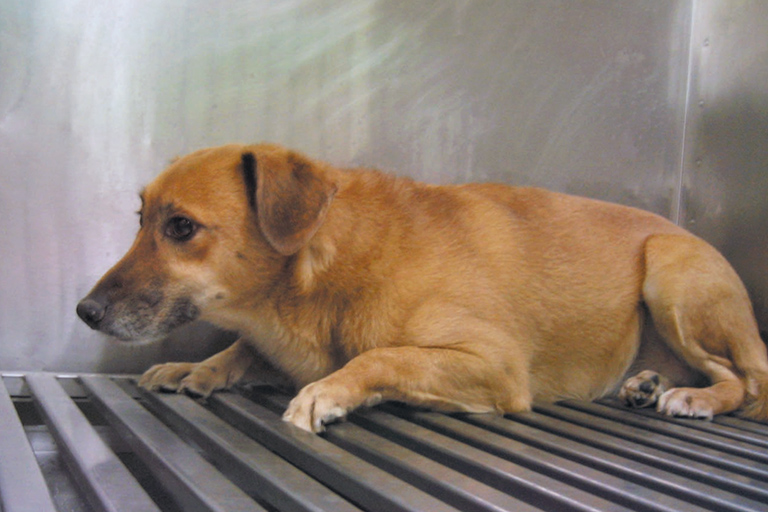
This Is A Live Lab.Meet Maxine, at an Iams research site. PETA's investigator sees dogs and cats recoil in prison-like cells. Many are here for years on end. To cope, they pace in nonstop circles, head bob, over-groom. Chronically stressed animals display stereotypies: Repetitive, unvarying behaviors that serve as coping mechanisms. Maxine tries to hide in her cage, but livens up when PETA's agent uncages her for a rare moment of comfort.
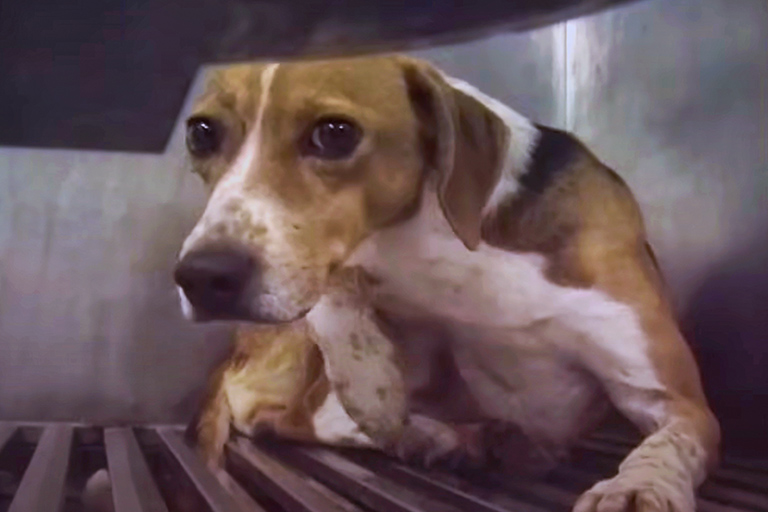
This Is Sally.Born for research. Six years later Sally stumbles over splinted steel floors, too afraid to sleep. She cowers when the PETA investigator tries to comfort her. Dogs like Sally have their vocal cords slashed. Their desperate barks annoy the lab director, so he orders a maiming of convenience, a bloody laceration to silence them. Iams officials witness the distress but do nothing. Even pleas to give animals a resting board and exercise are dismissed.
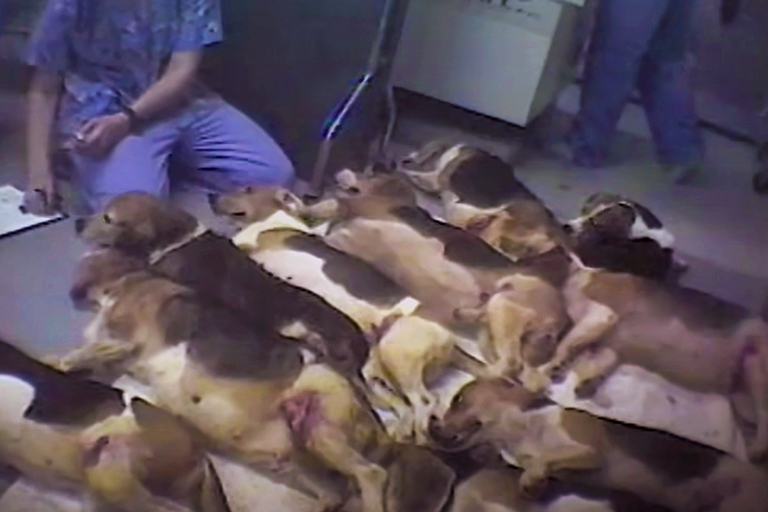
This Is Sheer Cruelty.Dogs and cats undergo mutilation surgeries to evoke synthetic injury or disease for lab experiments. In PETA's most heinous footage, 60 or more Beagles are found piled on a dirty, paint-peeling floor with deep flesh wounds. Slabs of muscle are cut from their thighs. Some can't move. Others try to lift their heads or drag themselves. The dogs, bewildered and in pain, are discarded in a grimy room — some clumped atop each other.
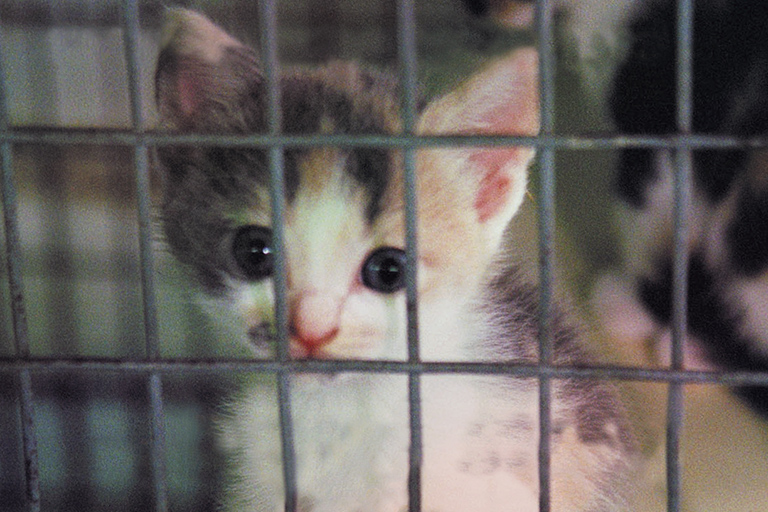
This Is No-Name.This kitten is among many cats PETA sees isolated in cages for pet-food testing. Iams has funded studies that surgically carve out parts of kidneys to simulate renal failure in felines. In another test, cats’ stomachs are exposed so experimenters can watch fiber ingestion. Cats are overfed, then under-fed, to cause liver disease… Animal labs are loud and messy. While PETA is on-site, workers report a live kitten — flushed down a drain.
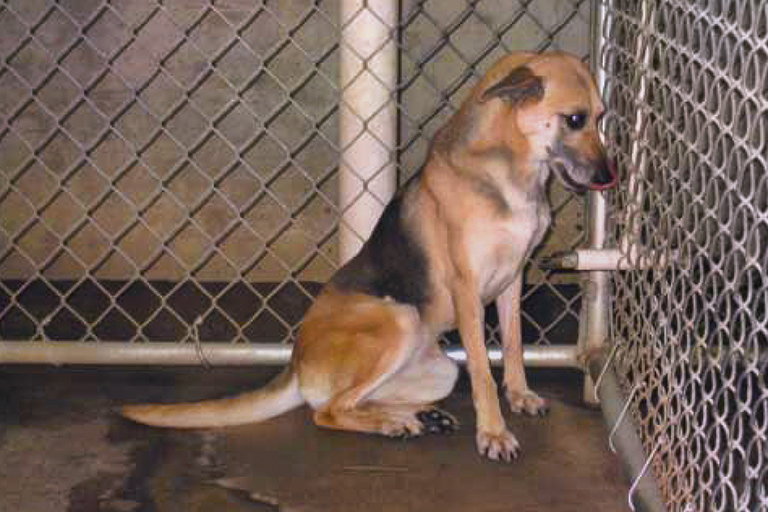
- Dogs and cats shrink into themselves, huddled in cages, some on soaked concrete.
- PETA observes untreated ear infections, rotting teeth and wounded paws.
- Kennels are sweltering in summer, bittery cold in winter.
- Dogs are force-fed vegetable oil via tubes embedded down their throats and into their stomachs.
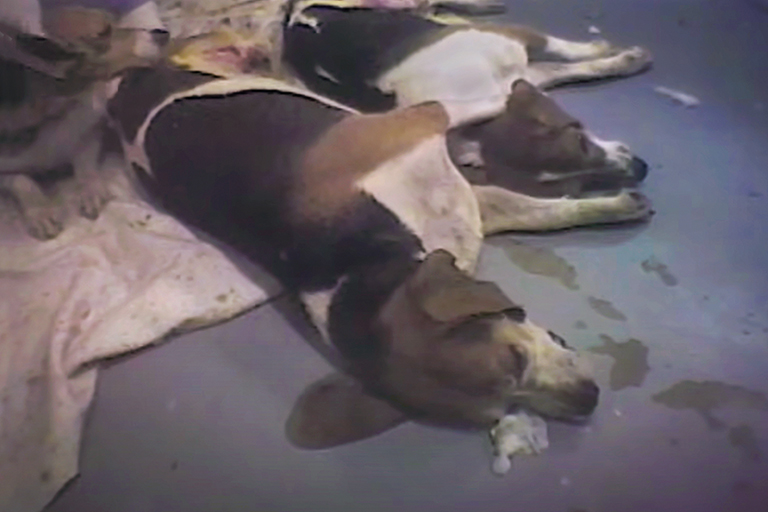
This Is Bullcrap.After PETA and Uncaged exposés, Iams proceeds discreetly. PETA says Iams may underwrite a chair position at a university with nutritional trial labs or sponsor animal research conferences. At the time Iams’ worst animal labs are uncovered, U.S. Federal Trade Commission cites Iams research policy as misleading and in violation of Section 5 of the FTC Act. The UK's Advertising Standards Authority calls for an investigation into Iams.
Iams On Record
1991 »
Aug 1991: Kidneys are extracted from dogs who undergo aggressive testing before killed for further analyzation. “Two diets similar in caloric density and mineral content, but markedly different in protein content, were used to study the effects of dietary protein on renal function and morphologic and histopathologic changes in dogs that had functional renal tissue reduced by 7-8s nephrectomy [surgery to remove all or part of a kidney]… The severity of renal lesions was indistinguishable between dogs of dietary groups during both study phases.”8 University of Georgia and The Iams Company: Effect of dietary protein on functional, morphologic, and histologic changes of the kidney during compensatory renal growth in dogs. Am J Vet Res, Vol 52, No. 8, Aug 1991: 1357-1365. JV White, Diane Hirakawa (Iams Senior Vice President of Research–Development), et al.
Summary ⮕ To induce “rapid onset, severe symptoms” of acute renal failure, the right kidneys are removed from 24 young mix-breed dogs. Through incisions in the abdomen, one kidney is dislodged. Blood flow to the remaining kidney is obstructed to impair 75% kidney function and leave dogs with 1/8 their normal renal capacity. When kidneys fail, accumulated waste in the blood leads to poisoning and death. Dogs may experience “depression, appetite loss, thirst, vomiting. The back may be arched, with stiffness. There is fever, and sometimes mouth ulcers (Black's Veterinary Dictionary: 292).” 22 dogs are analyzed up to 14 months. 4 dogs are euthanized due to severe uremia (excessive waste products in the blood › Oxford Medical Dictionary; death may be preceded by convulsions and unconsciousness › Black's Veterinary). 8 dogs are destroyed after 7 months to observe diseased kidneys. 10 more dogs are killed 7 months later. A 2001 expose in UK's Sunday Express reports: “24 young dogs had their right kidneys removed and the left partly damaged to investigate how protein affects dogs with kidney failure. 8 dogs were killed to analyse kidney tissue. Sick dogs were not treated because it would have undermined test results.”
1994 » Apr 1994: Intestinal sections are repeatedly cut out of the stomachs of 16 German Shepherds. “16 German Shepherd Dogs were found, via quantitative microbial culture of intestinal fluid samples, to have small intestinal bacterial overgrowth (IBO) over 11 months. All were deficient in serum IgA. Consistent clinical signs of an alimentary tract disorder were not observed… Difficulty in diagnosing IBO, variability in organisms found in individual dogs on repeated sampling, and the potential of IBO to be clinically inapparent were the most important findings in this study.” Texas A&M Univ and Iams Company: Characterization of naturally developing small intestinal bacterial overgrowth in 16 German Shepherd Dogs. JAVMA, Vol 204, No. 8, 4/15/1994: 1201-1206. MD Willard, Dan Carey (Iams Director of Technical Services), Gregory A. Reinhart (Iams Vice President, Strategic Research and Communications Research and Development Division), et al.9
- May 1994: “16 IgA-deficient German Shepherd Dogs with small intestinal bacterial overgrowth” undergo experiments to evaluate bacterial overgrowth in their small intestines. Texas A&M University and The Iams Company: Effects of dietary supplementation of fructo-oligosaccharides on small intestinal bacterial overgrowth in dogs. Am J Vet Res, Vol 55, No.5, May 1994: 654-659. MD Willard, G Reinhart (Iams), et al.10
- Sep 1994: Kidneys are extracted from 31 older dogs to stimulate renal damage. Dogs are examined for 48 months, then killed and dissected. “31 clinically normal Cocker Spaniels, Miniature Schnauzers, and Doberman Pinschers (28 female, 3 male) 7 to 8 years old were uninephrectomized (surgical excision of one kidney) to increase risk of renal damage associated with reduction of renal mass… At 48 months, terminal studies were done, survivors were euthanatized, and tissues were examined.” Univ of Georgia and Iams Company: Effects of aging and dietary protein intake on uninephrectomized geriatric dogs. Am J vet Res, Vol 55, No.9, September 1994: 1282-1290. Delmar R Finco, Daniel P Carey (Iams), Diane A Hirakawa (Iams) et al.11
1996 – 1997 » Stomachs are cut open and tubes affixed to the intestines of 15 adult Beagles. Each 10 minutes within a 2-hour block, stomach contents are mechanically purged through the tubes. All dogs are killed for an experiment that seeks to: “assess effects of dietary fiber (cellulose, beet pulp, pectin/gum arabic) on canine colonic mucosal DNA content, energetic activity and electrolyte transport systems.” Univ of Nebraska-Lincoln and Iams Company: Colonic mucosal tissue energetics and electrolyte transport in dogs fed cellulose, beet pulp or pectin/gum arabic as their primary fiber source. Nutrition Research, Vol 16, No.2: 303-313 (1996). JE Hallman, GA Reinhart (Iams) et al.12
- 1996: The intestines of dogs are exposed and bonded outside their bodies to study the effects of dietary fibers. Univ of Illinois and Iams Company: Nutrient Digestion by Ileal Cannulated Dogs as Affected by Dietary Fibers with Various Fermentation Characteristics. J. Anim. Sci. 1996. 74: 1641-1648. HE Muir, GA Reinhart (Iams) et al.13
- Jun 1996: After the kidneys of 18 healthy Beagle puppies are chemically damaged, they're fed trial diets. Tubes are implanted into their penises. All pups are killed. “Animals: 18 6-mon old male Beagles, 6 per group.” Colorado State Univ and Iams Company: Effects of dietary n-3 fatty acid supplementation versus thromboxane synthetase inhibition on gentamicin-induced nephrotoxicosis in healthy male dogs. AJVR, Vol 57, No.6, June 1996: 948-956. Gregory F Grauer, Gregory A Reinhart (Iams) et al.14
Kidneys are cut out of 8 dogs to examine the impact of protein on recovery from kidney removal. University of Georgia and The Iams Company: High dietary protein intake does not accelerate development of renal lesions during recovery from renal mass reduction in dogs. ACVIM Abstracts. Vol 3 No 2, p. 131/1996. JV White, DA Hirakawa (Iams) et al.
- 1997: Portions of large intestines are surgically carved out of 28 dogs to review influence of dietary fiber. University of Missouri and Iams Company: Dietary fiber sources alter colonic blood flow and epithelial cell proliferation of dogs. J. Anim. Sci. 1997. 74(Suppl. 1). MD Howard, Gregory Sunvold (Iams Director of Clinical Research and Intellectual Properties), GA Reinhart (Iams) et al.
1998 » 1/1/98: Bones from front and hind legs of 18 dogs are surgically exposed, manipulated and irritated until they fracture. Univ of Wisconsin and Iams Company: Nutritional Effects on Bone Strength in the Growing Canine, Proceedings of the 1998 Iams Nutrition Symposium: 29-40. Thomas D Crenshaw, Allan J Lepine (Iams), et al.15
- 1998: Portions of kidneys are surgically excised and(or inflamed to artificially produce kidney failure in 28 otherwise healthy cats. Cats who survive experimentation are then killed to gauge repercussions of protein intake on diseased kidneys. University of Georgia and The Iams Company: Influence of Protein and Energy in Cats with Renal Failure. In: Reinhart GA, Carey DP, eds. Recent Advances in Canine and Feline Nutrition, Volume II: 1998 Iams Nutrition Symposium Proceedings. D. Sunvold (Iams) et al.16
- 1998: Intestinal pieces are removed through the sliced open bellies of 16 dogs. “16 adult dogs (23 +/- 2 kg) were fed isoenergetic, isonitrogenous diets containing a mixture of high fermentable dietary fibers (HFF) or low fermentable (LFF) wood cellulose for 14 d… Intestinal samples were collected after the second dietary treatment.” University of Alberta and The Iams Company: Fermentable Dietary Fiber Increases GLP-1 Secretion and Improves Glucose Homeostasis Despite Increased Glucose Transport Capacity in Healthy Dogs. Journal of the American Society for Nutritional Sciences: 1786-1793 (1998). Stefan P Massimino, Michael G Hayek (Iams), Gregory D Sunvold (Iams) et al.17
- 1998: Intestinal sections are removed and immune systems are agitated in 16 dogs to explore the effects of fiber. University of Alberta and The Iams Company: Interaction of Fiber Fermentation and Immunology of the Gastrointestinal Tract, Proceedings of the 1998 Iams Nutrition Symposium: 523-530. Catherine J Field, Michael G Hayek (Iams), Gregory D Sunvold (Iams) et al.
- 1998: Large and small intestinal samples are extracted from 5 dogs to assess intestinal tract requirements. University of Illinois and The Iams Company: Energetic Substrates for Intestinal Cells, Proceedings of the 1998 Iams Nutrition Symposium: 463-472. James K Drackley, Gregory D Sunvold (Iams) et al.
- Jul 1998: To evaluate wound recovery during the inflammatory stage, 30 dogs are purposefully injured. Skin patches that contain the wounds are cut from their bodies. “Objectives: To ascertain the effects of dietary omega-3 fatty acids on the inflammatory stage of wound healing. Animals: 30 purpose-bred Beagles. Procedure: Dogs, allotted to 5 groups of 6, were fed a unique dietary fatty acid ratio of omega-6 to n-3…then biopsy specimens were taken from 4-day old wounds of each dog and analyzed…” Auburn Univ and Iams Company: Evaluation of the effects of omega-3 fatty acid-containing diets on the inflammatory stage of wound-healing in dogs. AJVR, Vol 59, No. 7, July 1998: 859-863. Mark A Mooney, Gregory A Reinhart (Iams) et al.18
- Dec 1998: After killing “6 healthy Great Danes aged 6 mon, available for the investigation,” experimenters “mince, lyophilize, fat extract with light petrol, dry and grind” the puppies to wage a “total body analysis… Puppies with an expected adult weight of 20 kg and more were considered as large, others as small or medium.” Ludwig-Maximilians University (Munich) and The Iams Company: Body composition of puppies and young dogs. J Nut 1998 Dec; 128(12):2680S-3S. Kienzle E., Jürgen Zentek (Iams Chair in Clinical Nutrition, University of Vienna, Austria), Meyer H.19
1999 » Tubes are grafted into the intestines of 6 dogs to regularly drain fluids, in an experimental attempt to weigh the efficacy of high-starch fibers (potato flour, sorghum, corn, barley) in canine diets. University of Illinois and The Iams Company: Evaluation of Selected High-Starch Flours as Ingredients in Canine Diets. J. Anim. Sci. 1999. 77:2180-2186. SM Murray, GD Sunvold (Iams), GA Reinhart (Iams) et al.20
- Mar 1999: 10 dogs are destroyed to analyze how various types of dietary fiber influence “intestinal dimensions and nutrient absorption. Animals: 10 adult Beagles. Procedure: Dogs are randomly assigned to 2 groups and fed a diet with fermentable fibers (beet pulp and oligofructose) or a nonfermentable fiber (cellulose) for 6 weeks. Effects on small intestinal dimensions are measured; transport rates for glucose and proline are determined. Kinetics of glucose and proline uptake are defined [via necropsy: dead dogs] in regions of the small intestine.” Mississippi State Univ and Iams Company: Influence of fermentable fiber on small intestinal dimensions and transport of glucose and proline in dogs. AJVR, Vol 60, No.3, March 1999: 354-358. Randal K Buddington, Greg D Sunvold (Iams) et al.21
2000 » In a 2-hour operation, the stomachs of 28 cats are laid open to let experimenters observe reactions to fiber ingestion. All cats are killed. Univ of Nebraska-Lincoln and Iams Company: Feline colonic microbes and fatty acid transport: effects of feeding cellulose, beet pulp and pectin/gum arabic fibers. Nutrition Research, Vol 20, No.9, pp. 1319-1328 (2000). AR Bueno, GD Sunvold (Iams), GA Reinhart (Iams) et al.22 Summary ⮕ Short-hair female cats, ages 2-5, are divided into sets of 2 or 3, caged indoors, and fed various diets for 2-3 weeks. One cat is discarded for “a unthrifty appearance.” Animals anesthetized for the “colonic perfusion study” are positioned on their sides to split open their abdomens. A catheter is installed in their colons. A tube is also forced inside each animal's rectum. After their bowels are flushed, a test solution is pumped through empty bowels and collected every 10 minutes over 2 hours. In the next phase, sections of the caecum and colon are extracted. The paper does not indicate whether cats are killed before, during or after this phase.
“In another experiment, the stomachs of 28 cats were exposed so scientists could analyse the effects of feeding them fibre. The animals were operated on for at least 2 hours and then killed.” UK Sunday Express report on Iams cat-dog experimentation
- May 2000: 24 female cats are sterilized and over-fed until clinically obese, followed by drastic food-reduction to imitate “rapid weight loss in cats.” Three liver biopsies are performed on the cats during testing. University of Kentucky and The Iams Company: Effect of dietary protein quality and fatty acid composition on plasma lipoprotein concentrations and hepatic triglyceride fatty acid synthesis in obese cats undergoing rapid weight loss. AJVR, Vol 61, No.5, May 2000: 566-572. Wissam H Ibrahim, Gregory D Sunvold (Iams) et al.23
Summary ⮕ 24 female cats, ages 2-5, are purchased from a commercial dealer and confined separately. Each cat is “ovariohysterectomized” and fed a “high quality energy dense diet” (Iams Eukanuba) until all are clinically obese at 80 days. Experimenters comment: “Obese cats are at greater risk for development of osteoarthritis, ligament injuries, perineal dermatitis (inflammation of skin near genitals), diabetes mellitus, lower urinary tract disease, and cardiomyopathy (heart disease). Mortality risk is also increased.” After the obesity phase, cats undergo a 7-8 week crash diet, consuming 25% of their “energy requirements” until they lose “30 to 40% of their obese body weight.” During this stage, 2 cats are unable to ingest even a quarter of their nutritional requirements. Experimenters admit: “Safe, rapid weight loss in cats can be difficult, because cats…are more susceptible than other species to HL (hepatic lipidosis).” 3 cats progress to HL impaired liver function. All cats endure invasive liver biopsies. UK Express report: “The research team sterilised 24 female cats, which were over-fed until they become obese. They were then starved on a crash diet and when they had lost a third of their weight their livers were examined to investigate the link between weight loss and liver disease.”
In their lifelong tenure as test subjects, animals are constantly needle-jabbed for blood draws. They're crated and caged in sterile lab environs. Some never feel grass beneath their paws or sunlight on their backs. Beagles, the most commonly bred dogs for experimentation, are scent hounds denied their natural instinct to chase unseen smells in air and ground. The lucky few find eventual refuge with groups like Beagle Freedom Project, a nonprofit charity that rescues animals used for research.
- 2000: Newborn husky puppies are injected with live virus vaccines and allergens to elicit chronic allergic response. 14 pups suffer illness and allergies. University of Calgary and The Iams Company: Hypersensitivity Reactions to Dietary Antigens in Atopic Dogs. Proceedings of the 2000 Iams Nutrition Symposium: 69-77. Merle E Olson, Michael G Hayek (Iams) et al.24
Summary ⮕ 11 “Crossbred sled” newborn puppies are injected with a cocktail of attenuated live virus vaccines — distemper, hepatitis and parvovirus — 10 times over the first 85 days of life. Food antigens are also administered subcutaneously. 3 more non-sensitised dogs undergo the same procedures. Skin tests are conducted at 6 and 10 months of age [no reference to anesthesia]. Food allergens (soy, casein, chicken liver) are injected “intradermally” at 4 potency levels. Low-strength doses generally provoke a skin reaction. High magnitude injections are 100,000 times stronger than lowest concentration injections (0.02 micrograms vs 2000 micrograms). Some high-concentration injections trigger welts similar to large hives. Allergens are also injected into each puppy's stomach lining to probe gastroscopic food sensitivity. The higher strength inoculations prompt expansion of blood capillaries (erythema and oedema), resulting in moderate to severe inflammation with fluid-filled bulges and redness. Skin and stomach results are monitored for a month, while puppies consume allergic diets. Experimenters record: “[All 11 puppies] develop moderate to severe diarrhea and lose weight. Furthermore 8 of the 11 sensitised dogs demonstrate dermatological reactions that include hair loss and pruritis [eczema-like itching]… Moderate to severe pruritis, with and without lesions, is also observed.” UK Express report: “Iams sponsored research in which 14 husky puppies were repeatedly injected with live vaccines and allergy causing proteins for the first 12 weeks of their lives. They developed permanent illnesses in the test, which was designed to see how severely allergic they'd become.”
5/6/14: Beagle Freedom Project rescues beagles from a Nevada laboratory. Until this moment, none of the dogs have known gentle touch, love or safety. None have felt soft ground beneath their paws, played or run with abandon… Until now.
- 2000: Chest wounds are inflicted upon 36 dogs to study the role of diet in fur regrowth. Tests are predicated on the rationale that dogs with drab coats “are not handled as much.” Texas A&M and Iams Company: The Role of Nutrition on the Canine Hair Follicle: A Preliminary Report, Proceedings of the 2000 Iams Nutrition Symposium: 37-53. Kelly M Credille, GA Reinhart (Iams), GM Davenport (Iams) et al.25 Summary ⮕ Under local anesthetic, 6mm portions of skin are biopsied from 12 Siberian Huskies, 12 Miniature Poodles, and 12 Labrador Retrievers every 3 weeks for 18 weeks. Each dog sustains 12 body wounds. Experimenters acknowledge: “Overall, there is little to distinguish the dogs fed the high and low quality diets.” A UK Express story states: “12 huskies, 12 poodles and 12 labradors were regularly given chest wounds to see if diet could affect fur regrowth. This was justified on the grounds that ‘dogs are enjoyable to touch and look at. Dogs with coat problems are simply not handled as much.’”
- 2000: Bone and cartilage are surgically extracted from healthy puppies, chicks and rats to observe bone and joint regeneration. Purdue University and The Iams Company: Relationships of Fat Quality and Antioxidants in Bone and Cartilage, Proceedings of the 2000 Iams Nutrition Symposium: 505-514. Bruce A Watkins, Allan J Lepine (Iams), C. Gregory Aldrich (Iams), Michael G Hayek (Iams), et al.
- 2000: The ovaries and uteruses of 56 dogs are removed to contemplate how beta carotene impacts reproductive performance. Washington State University and The Iams Company: Beta-Carotene uptake and changes in ovarian steroids and uterine proteins during the estrous cycle in the canine. J. Anim. Sci. 2000. 78:1284-1290. BC Weng, AJ Lepine (Iams), et al.26
- 2000: Tubes are implanted through the chests of 8 healthy dogs to examine fat absorption. The Ohio State University and The Iams Company: Transport Pathways of Enterally Administered Medium-Chain Triglycerides in Dogs, Proceedings of the 2000 Iams Nutrition Symposium: 143-152. Jennifer D Newton, GA Reinhart (Iams), et al.
2002 – 2003 » Nov 2002 - Oct 2005: Iams funds Univ of Mississippi Medical Center's Dr. Roger B. Johnson to invoke gingivitis in 21 beagles. Dogs’ gums are cut and sutured to mimic this painful stage of periodontal disease in another Iams study.27
- Jan 2002: “I received a letter from a student at the University of Illinois, asking if I could make some suggestions as to what they could do about 9 dogs [who] were housed in a windowless lab at the university. These dogs had cannulas (tubes) surgically implanted in their sides so that samples of digested food could be taken. The studies included feeding the dogs raw and rendered animal by-products including ‘poultry necks and backs and viscera, and ground-up poultry feathers.’ Until 2002, this research was funded by the Iams company, but now is funded by the soybean industry and US Department of Agriculture.”28
- Nov-Dec 2003: To analyze how immune response varies in accordance with age, 36 young and old dogs are injected with beta-carotene, for tests about “whether beta-carotene is able to reverse age-associated decline. Young and old dogs (n = 36) were fed either a control diet or experimental diets containing supplemental beta-carotene for 2-month periods… beta-carotene improved these responses, mostly within 24-48 hours after injection. In summary, older dogs have lower immunological responses compared with younger controls.” Research and Development, The Iams Company, Lewisburg, OH: Effects of age and dietary beta-carotene on immunological variables in dogs. J Vet Intern Med. 2003 Nov-Dec;17(6):835-42. Stefan Massimino (Iams), Robert J Kearns, Kathleen M Loos, John Burr, Jean Soon Park, Boon Chew, Scott Adams, Michael G Hayek (Iams).29
2004 »
Iams Doublespeak: In a 2004 shareholder proxy statement, Procter & Gamble claims, “Iams must use controlled kennel or cattery nutritional studies to confirm a significant new health benefit and its safety for dogs or cats… [To] end all kennel or cattery feeding studies would impede efforts to enhance the well-being of dogs and cats.” Really? Back in 2001, Diane Hirakawa, senior vice president, Iams Research & Development, states unequivocally: “The lesson learned here is that kennel studies are not an appropriate way to test feeding guidelines because most kennels represent a high-stress environment.” Ding ding ding. Diane has the correct answer. Truth About Pet Food explains in Pet Food Animal Testing: “Almost all feeding trials are performed at laboratory kennels. Cats and dogs are specifically bred to be test subjects. Most never have a home or see daylight. Cats and dogs are born, raised and die within lab settings.”
- Jan 2004: Nutraceutical compounds are tested on dogs and cats to assess how they interact with the immune system. “Interactions may be positive or negative depending on the compound or dose administered to the individual [animal].” Iams Company Research–Development: Modulation of immune response through nutraceutical interventions: implications for canine and feline health. Vet Clin North Am Small Anim Pract. 2004 Jan;34(1):229-47. Michael G Hayek (Iams), Stefan P Massimino, Michael A Ceddia.30
- Spring 2004: “This study indicates that measuring caloric intake data of dogs in homes is achievable and can provide a practical and appropriate methodology for determining energy needs. This knowledge can be helpful in developing appropriate guidelines for pet food labels.” The Iams Company, Research and Development: Feeding practices of pet dogs and determination of an allometric feeding equation. Vet Ther. 2004 Spring;5(1):82-99. Gregory D Sunvold (Iams), Sharon A Norton, Daniel P Carey, Diane A S Hirakawa (Iams), Linda P Case.31
2005 – 2006 » 5/1/04 to 6/30/06: Iams Company awards Purdue University $195,140 to study “Influence of N-3 Polyunsaturated Fatty Acids (PUFA) on Musculoskeletal Atrophy During Unloading.”32 Researchers Dr. Bruce Watkins and Dr. Kevin Hannon apply “a piece of surgical tape to the tail [of mice] to hoist their rear limbs off the floor.” Mice undergo 7 days of hind-limb muscle atrophy. After they lose use of their back legs, all mice are killed. This study ends after public blowback. Cardiac puncture is a routine way to draw blood from lab mice. Mice are partly euthanized pre-puncture. They're confined in carbon dioxide chambers until breathing stops but heartbeat and blood flow continue.33 Mice, the go-to model for disease and injury, have proven over decades to supply inaccurate data. Discrepancies between species — genetic, metabolic, anatomic, physiological, psychological — render mice largely useless when findings are intended for humans or other animals.34 2005: Iams funds Dr. Larry Arlian, at Wright State University, to replicate Tyrophagus putrescentiae (TP, the most common stored-product mite) in rabbits. USDA has previously cited Dr. Arlian in 7/12/93 charges that WSU violates Animal Welfare Act rules.
2008 » 8/28/08 Washington, DC (RushPRNews): USDA releases a complaint against Sinclair Research Center for “a lack of good faith.” The complaint cites 2002-2005 violations at the contract animal research lab, including failure to: Give pain relief to sheep in painful experiments; Use trained personnel to perform animal experiments; Provide veterinary care; Properly ventilate cat-dog housing; Maintain facilities in good repair, resulting in animal injuries; Offer animals space to move… A PETA investigation at the Missouri-based lab, then under contract with Iams, reveals dogs traumatized in empty metal cages and concrete cells. Dogs are seen heaped on a dirty, paint-chipped floor after slabs of muscle have been excised from their thighs. Gravely sick cats and dogs wither in cages. Iams reps who visit the lab see overheated dogs pace in outdoor cages, but do nothing. A USDA inspection, in response to PETA's complaint, cites Sinclair for more than 40 violations of the Animal Welfare Act. The lab pays $33,000 in penalties.35
Iams claims 70% of animal subjects now live in volunteer homes for food/nutrition trials. Guardians feed their animals and collect fecal-urine samples for analysis. Other animal-testing pet brands make similar promises: No suffering or euthanasia. True, if animals are observed in family homes. False, for those still used in laboratories. In labs, animals exist in perpetual distress from handling, confinement, noise, isolation, pain, fear… Stress hormones influence data and can lead experimenters down false pathways.36 In-home testing, however, has a proven success rate for “humane animal food/product testing,” PetSci program, Dr. Charles Abramson and Dr. Timothy Bowser.37
2009 » PETA (along with Kinship Circle and many animal groups) keeps the heat on Iams in protest campaigns against brutal animal experiments. Iams parts ways with Sinclair Research Center, the contract lab cited for egregious animal welfare violations. Iams, evasive about animal usage, won't grant PETA access to their facility. On paper, Iams consents to stop invasive and lethal experiments on cats and dogs, plus initiate in-home palatability tests. Why does Iams resort to lab tests for at least 30% of its data? Iams says some data is too complex to extrapolate from home tests. PETA learns that Iams “still keeps as many as 700 dogs locked up in its laboratories for feeding trials and nutritional studies.”38
2014 – 2015 » 2014: Iams owner Procter & Gamble issues its perennial promise for reductions in animal testing, as better informed consumers demand cruelty-free pet care products.39 While P&G does delete some animal models, and to its credit has devised more than 50 non-animal methodologies with a $400 million investment in development and validation of animal-free research — by 2023 the company has yet to make animal tests obsolete. Apr 2014: Procter & Gamble gets out of the pet food biz. In a sweeping divestiture that nets P&G $2.9 billion, the company sheds its worldwide pet care labels. P&G explains the deal as a way “to lose a slow performer and generate cash to grow core businesses.“40 Amid lagging sales, recalls and scrutiny over animal testing, P&G sells off its Pet Care operations in North America, Latin America, Asia Pacific, Middle East and Africa to Mars, Inc. Its European lines are sold to Spectrum Brands.41
- 6/8/15: Experimental laboratory data is “derived from healthy adult Labrador Retrievers in the fasted and fed states.” The study defines glucose kinetics in a new two-pool model. University of Guelph; Instituto de Ganadería de Montaña (CSIC-ULE); The Iams Company: A Kinetic Model of Whole-Body Glucose Metabolism with Reference to the Domestic Dog (Canis lupus familiaris). Int Sch Res Notices. 2015 Jun 8:2015:286076. Leslie L McKnight, Anna K Shoveller (Iams), Secundino Lopez, James France.42
- 6/16/15: Adult Beagle dogs are laboratory restrained, with blood samples regularly taken after overnight fasts and post-meals, to study how nutraceuticals (foods with added medicinal benefit) effect weight management. Experimenters examine the capacity for avocado sugar (mannoheptulose MH), which inhibits glycolysis, to influence energy metabolism. Dogs undergo tests for calorimetry and bone density (dual X-ray absorptiometry). University of Guelph and The Iams Company: Dietary Mannoheptulose Increases Fasting Serum Glucagon Like Peptide-1 and Post-Prandial Serum Ghrelin Concentrations in Adult Beagle Dogs. Animals (Basel). 2015 Jun 16;5(2):442-54. Leslie L McKnight, Ryan Eyre (Iams), Margaret A Gooding (Iams), Gary M Davenport (Iams), Anna Kate Shoveller (Iams).43
2016 – 2017 » 2016: 20 cats, average 4.5-years, are fed in lab “2 dietary treatments” to study affects of L-carnitine in Iams pet foods. “On cognition testing days feeding programs were altered for individual cats undergoing testing as food was used as a reward.” Iams Company, Mars PetCare: Cats in Positive Energy Balance Have Lower Rates of Adipose Gain When Fed Diets Containing 188 versus 121 ppm L-Carnitine. ScientificWorldJournal. 2016:2016:2649093. M A Gooding (Iams), D L Minikhiem (Iams), A K Shoveller (Iams).44
- 11/8/17: Digestibility and metabolism of dietary starch are tested across 3 commercial diets in vivo and in vitro in laboratory housed cats. Univ of Illinois; Univ of Guelph; Univ of Alberta; Iams Company: Digestibility Is Similar between Commercial Diets That Provide Ingredients with Different Perceived Glycemic Responses and the Inaccuracy of Using the Modified Atwater Calculation to Calculate Metabolizable Energy. Vet Sci. 2017 Nov 8;4(4):54. Natalie J Asaro, Marcial A Guevara (Iams), Kimberley Berendt, Ruurd Zijlstra, Anna K Shoveller (Iams).45
- Dec 2017: 10 (5 lean, 5 overweight), neutered, adult American Shorthair cats undergo tests in a lab setting that offers “free-living with indoor/outdoor access.” The study proves “overweight cats are less active than lean cats;” voluntary activity is “influenced by social interaction with humans.” Univ of Illinois; Univ of Guelph; Iams Company, Mars Pet Care: Overweight adult cats have significantly lower voluntary physical activity than adult lean cats. J Feline Med Surg. 2017 Dec;19(12):1267-1273. Maria Rc de Godoy, Anna K Shoveller (Iams).46
2018 » Aug 2018: “To assess the impact of omega-3 fatty acid on skeletal growth, diets containing three levels of DHA and EPA were fed to bitches during gestation and lactation with puppies also supplemented through weaning.” Puppies are studied from gestation to early postnatal life with “hip joint conformation…recorded at adulthood” Dept of Animal Science, Univ of Calif, Davis; Canine Companions for Independence, Santa Rosa, CA; The Iams Company, P&G Pet Care, Mason, OH: Maternal omega-3 polyunsaturated fatty acid supplementation on offspring hip joint conformation. PLoS One. 2018 Aug 9;13(8):e0202157. A M Oberbauer, R Daniels, K Levy, T R Famula, P Mundell, R Kelley (Iams).47
- Oct 2018: This controlled clinical trial feeds “36 healthy, female adult mixed-breed hound dogs” a control diet or “several experimental diets with graded concentrations of tryptophan.” Blood draws are performed for laboratory analysis. Behavioral patterns are evaluated and scored. University of Guelph, Department of Animal Biosciences and The Iams Company, Procter & Gamble Pet Care Division: The effect of graded concentrations of dietary tryptophan on canine behavior in response to the approach of a familiar or unfamiliar individual. Can J Vet Res. 2018 Oct;82(4):294-305. James R Templeman, Gary M Davenport (Iams), John P Cant, Vern R Osborne, Anna-Kate Shoveller (Iams).48
- Dec 2018: Domestic shorthair cats, 10 males and 9 females, are fed once daily 1 of “3 commercial diets differing in carbohydrate content and source, to determine glucose and insulin responses of cats.” Interstitial glucose measurements are taken (a sensor inserted under skin attaches to device that measures glucose level within interstitial fluid). Repeat blood samples are needle-drawn in cats to gauge blood glucose and insulin. University of Guelph, Dept of Animal Biosciences; University of Alberta, Dept of Agricultural, Food, and Nutritional Science; and The Iams Company, Procter & Gamble: Carbohydrate level and source have minimal effects on feline energy and macronutrient metabolism. J Anim Sci. 2018 Dec 3;96(12):5052-5063. James R Templeman, Gary M Davenport (Iams), John P Cant, Vern R Osborne, Anna-Kate Shoveller (Iams).49
2023 – Present » Iams says any testing is done internally, so it can monitor protocols. Owned by Procter & Gamble till 2014, Iams (and most pet care lines that test on animals) remains vague about invasivity of lab trials. By 2023, P&G itself is not cruelty-free. Animal tests are conducted in-house or via suppliers and third parties.50 P&G states: “We believe that eliminating animal testing is the right thing to do. We do not test our products or ingredients on animals anywhere in the world unless required by law. We are working hard to make it obsolete.” While this may assuage some consumers, many brands make the same items in P&G's vast portfolio — hair-skin-cosmetics, feminine hygiene, dental health, baby care, household cleaners, detergents, health — with zero animal tests. Mars, Inc. owns Iams, Eukanuba and Natura brands. The company does animal experiments that “must not inflict suffering, harm or result in euthanasia.”51 Mars claims that “development of our products and services” does not involve “studies that harm animals.” But animal experimentation, by definition, must harm animals to disrupt their biological function and behavior. Only then can animal tests fulfill the primary goals of scientific method: description, prediction, explanation, control.
BUYER BEWARE
These parent companies, and most of their brands, do lab feeding trials and/or test ingredients, chemicals, additives on cats, dogs, other animals:
- Mars, Inc:
Iams, Eukanuba
Pedigree, Whiskas
Catsan, Cesar
Chappie, Crave
Dreamies, Greenies
Temptations, Sheba
Nutro, Orijen
Nom Nom - Royal Canin (subsidiary of Mars):
Non-script Royal Canin pet foods
Prescription Royal Canin pet foods - Colgate-Palmolive:
Hill's Science Diet
Hill's Prescription Diet - Nestlé:
Purina, Purina One
Proplan, Proplan Veterinary Diets
Friskies, Dog Chow, Bakers Complete
Cat Chow, Purina Gourmet
Fancy Feast, Felix, DentaLife
Prime Dog Treats & Chews
Purina Cat Treats & Toppers - Big Heart Pet Brands (The J.M. Smucker Co.):
Meow Mix, Milk-Bone
Kibbles n’ Bits, 9Lives
Pup-Peroni, Canine Carry Outs
Gravy Train, Milo's Kitchen
Nature's Recipe - Canidae, Natural Balance
(Two companies merged in 2023) - Blue Buffalo
(General Mills)
And More Brands:
- Before you buy: Ask If Your Food Was Tested On Lab Kennel Animals
Pet Food Companies That Don't Animal Test:
- Almo Nature
- Amore Pet Foods
- Artemis Pet Food
- Azmira Holistic Animal Care
- Barkz
- Benevo
- Bravo Raw Diet
- Burns Pet Health
- CaniSource
- Dingonatura
- Dr. Harvey's
- Dynamite Marketing
- Feline's Pride
- Fish4Dogs
- Flinch River Ranch
- Fromm Family Foods
- Halo, Purely For Pets
- Happy Dog Food
- Holistic Blend
- JR Farm
- Lucky Kitty
- Max & Ruffy's
- Newman's Own Organics
- Nutri-Vet
- Oma's Pride
- Pet Chef Express
- PET Fit
- Pet Guard
- Pets Deli
- Pooch & Mutt
- PoshNosh
- Primal Pet Foods
- Raw Advantage
- Sauder Feeds
- Sojourner Farms
- Solid Gold
- Stella & Chewy's
- The Honest Kitchen
- Timberwolf Organics
- V-Dog
- Veterinary Nutritional Formula
- Weruva
- Wysong Professional Diets
- Yarrah
LEARN MORE »
Footnotes
- 1. PETA Investigations Recap. 43 Times PETA Blew the Lid Off Animal Abuse. People For The Ethical Treatment Of Animals 8/17/23.
- 2. Review Top Companion Anim Med. Reproduction of Domestic Cats in Laboratories, Catteries, and Feral Colonies: A Review. Theros T Ng (College of Veterinary Medicine, Western University of Health Sciences, Pomona, CA. therosng@westernu.edu), Andrea J Fascetti, Jennifer A Larsen (Molecular Biosciences, School of Veterinary Medicine, University of CA, Davis). 2023 Jul-Aug:55:100780. doi: 10.1016/j.tcam.2023.100780. Epub 2023 May 22.
- 3. Uncaged Archives: The Iams Exposé. Iams: The Awful Truth. Introduction; Uncaged Comment; Summaries Of Studies.
- 4. Uncaged Archives: Iams. Pet Food Cruelty Exposed. Sunday Express, By Lucy Johnson.
- 5. Uncaged Archives: Iams Index. Iams – The Suffering Behind The ‘Science’.
- 6. Uncaged Archives: Iams News. Iams Cruel Chick Tests.
- 7. Truth About Pet Food. Are you buying a pet food that is based on animal testing? Unknowingly consumers could be supporting companies that test on live animals in laboratory/kennel settings. Pet Food News. Pet Food Animal Testing.
- 8. National Institutes Of Health (NIH). Effect of dietary protein on functional, morphologic, and histologic changes of the kidney during compensatory renal growth in dogs. JV White, Diane Hirakawa (Iams Senior Vice President of Research–Development), et al. Am J Vet Res, Vol 52, No. 8. Aug 1991: 1357-1365.
- 9. National Institutes Of Health (NIH). Characterization of naturally developing small intestinal bacterial overgrowth in 16 German shepherd dogs. Willard MD, Simpson RB, Fossum TW, Cohen ND, Delles EK, Kolp DL, Dan Carey (Iams Director of Technical Services), Gregory A. Reinhart (Iams Vice President, Strategic Research and Communications Research and Development Division). Journal of the American Veterinary Medical Association (JAVMA). 1994 Apr 15; 204(8):1201-6. PMID: 8014087.
- 10. National Institutes Of Health (NIH). Effects of dietary supplementation of fructo-oligosaccharides on small intestinal bacterial overgrowth in dogs. Willard MD, Simpson RB, Delles EK, Cohen ND, Fossum TW, Kolp D, G Reinhart (Iams). Am J Vet Res. 1994 May; 55(5):654-9. PMID: 8067613.
- 11. National Institutes Of Health (NIH). Effects of aging and dietary protein intake on uninephrectomized geriatric dogs. Finco DR, Brown SA, Crowell WA, Brown CA, Barsanti JA, Daniel P Carey (Iams), Diane Hirakawa (Iams Senior Vice President of Research–Development). Am J Vet Res. 1994 Sep; 55(9):1282-90. PMID: 7802397.
- 12. ScienceDirect. Colonic mucosal tissue energetics and electrolyte transport in dogs fed cellulose, beet pulp or pectin/gum arabic as their primary fiber source. J.E. Hallman, G.A. Reinhart (Iams), E.A. Wallace, A. Milliken, E.T. Clemens. Nutrition Research, Volume 16, Issue 2, 1996, Pages 303-313, ISSN 0271-5317.
- 13. National Institutes Of Health (NIH). Nutrient digestion by ileal cannulated dogs as affected by dietary fibers with various fermentation characteristics. Muir HE, Murray SM, Fahey GC Jr, Merchen NR, G.A. Reinhart (Iams). J Anim Sci. 1996 Jul; 74(7):1641-8. doi: 10.2527/1996.7471641x. PMID: 8818810.
- 14. National Institutes Of Health (NIH). Effects of dietary n-3 fatty acid supplementation versus thromboxane synthetase inhibition on gentamicin-induced nephrotoxicosis in healthy male dogs. Grauer GF, Greco DS, Behrend EN, Fettman MJ, Mani I, Getzy DM, Gregory A Reinhart (Iams). Am J Vet Res. 1996 Jun; 57(6):948-56. PMID: 8725828.
- 15. Proceedings of the 1998 Iams Nutrition Symposium: 29-40. Nutritional effects on bone strength in the growing canine. Thomas D Crenshaw, Allan J Lepine (Iams Research and Development Division), G.A. Reinhart, D.P. Carey (Iams). Recent Advances in Canine and Feline Nutrition, Volume II. pp 29-40. Orange Frazer Press, Wilmington, OH · 1/1/1998.
- 16. ResearchGate. Influence of Protein and Energy in Cats with Renal Failure. Smart, Marion. (2000). Eds: Reinhart GA (Iams), Carey DP (Iams). Recent Advances in Canine and Feline Nutrition, Vol II: 1998 lams Nutrition Symposium. Canadian Veterinary Journal. 41. 243-243.
- 17. National Institutes Of Health (NIH). Fermentable dietary fiber increases GLP-1 secretion and improves glucose homeostasis despite increased intestinal glucose transport capacity in healthy dogs. Massimino SP, McBurney MI, Field CJ, Thomson AB, Keelan M, Michael G Hayek (Iams), Gregory D Sunvold (Iams). J Nutr. 1998 Oct; 128(10):1786-93. doi: 10.1093/jn/128.10.1786. PMID: 9772150.
- 18. National Institutes Of Health (NIH). Evaluation of the effects of omega-3 fatty acid-containing diets on the inflammatory stage of wound healing in dogs. Mooney MA, Vaughn DM, Reinhart GA (Iams), Powers RD, Wright JC, Hoffman CE, Swaim SF, Baker HJ. Am J Vet Res. 1998 Jul; 59(7):859-63. PMID: 9659552.
- 19. ScienceDirect; NIH. Body composition of puppies and young dogs. Ellen Kienzle, Jürgen Zentek (Iams Chair in Clinical Nutrition, University of Vienna, Austria), Helmut Meyer. The Journal of Nutrition Volume 128, Issue 12, December 1998, Pages S2680-S2683. Available online 1 December 1998, Version of Record 11 February 2023. PMID: 9868240.
- 20. NIH. Evaluation of selected high-starch flours as ingredients in canine diets. Murray SM, Fahey GC Jr, Merchen NR, GD Sunvold (Iams), GA Reinhart (Iams). J Anim Sci. 1999 Aug; 77(8):2180-6. doi: 10.2527/1999.7782180x. PMID: 10461997.
- 21. NIH. Influence of fermentable fiber on small intestinal dimensions and transport of glucose and proline in dogs. Buddington RK, Buddington KK, Greg D Sunvold (Iams). Am J Vet Res. 1999 Mar; 60(3):354-8. PMID: 10188819.
- 22. ScienceDirect. Feline colonic microbes and fatty acid transport: effects of feeding cellulose, beet pulp and pectin/gum arabic fibers. A.R. Bueno MS, T.G. Cappel MS, G.D. Sunvold PhD (Iams), R.A. Moxley DVM, PhD, G.A. Reinhart PhD (Iams), E.T. Clemens PhD. Nutrition Research Volume 20, Issue 9, September 2000, Pages 1319-1328. Animal study. Accepted 3 April 2000.
- 23. NIH. Effect of dietary protein quality and fatty acid composition on plasma lipoprotein concentrations and hepatic triglyceride fatty acid synthesis in obese cats undergoing rapid weight loss. Ibrahim WH, Szabo J, Gregory D Sunvold (Iams), Kelleher JK, Bruckner GG. Am J Vet Res. 2000 May; 61(5):566-72. doi: 10.2460/ajvr.2000.61.566. PMID: 10803654.
- 24. Amazon Book. Recent Advances in Canine and Feline Nutrition. 2000 Iams Nutrition Symposium Proceedings, Vol. 3 Hardcover July 1, 2000. by Gregory A. Reinhart (Iams, Editor), Daniel P. Carey (Iams, Editor), Merle E Olson, Michael G Hayek (Iams).
- 25. Texas A&M Agriculeural Research Extension Center. The Role of Nutrition on the Canine Hair Follicle: A Preliminary Report. Proceedings of the 2000 Iams Nutrition Symposium: 37-53. Kelly M Credille DVM, C.J. Lupion PhD, R.A. Kennis DVM, R.L. Maier DVM, J. Driezye DVM, S. Castle BS, G.A. Reinhart PhD (Iams), G.M. Davenport PhD (Iams), R.W. Dunstan DVM, MS.
- 26. National Institutes Of Health (NIH). Beta-carotene uptake and changes in ovarian steroids and uterine proteins during the estrous cycle in the canine. Weng BC, Chew BP, Wong TS, Park JS, Kim HW, AJ Lepine (Iams). J Anim Sci. 2000 May; 78(5):1284-90. doi: 10.2527/2000.7851284x. PMID: 10834584.
- 27. ResearchGate. University of Mississippi Medical Center Dental Research On Dogs. Roger B Johnson DDS, PhD. UM Periodontics and Preventive Sciences.
- 28. Sirius Dog. The Pet Food Industry And Its Questionable Practices. Ann N. Martin.
- 29. National Institutes Of Health (NIH). Effects of age and dietary beta-carotene on immunological variables in dogs. Stefan Massimino (Iams), Robert J Kearns, Kathleen M Loos, John Burr, Jean Soon Park, Boon Chew, Scott Adams, Michael G Hayek (Iams). J Vet Intern Med. 2003 Nov-Dec; 17(6):835-42. doi: 10.1111/j.1939-1676.2003.tb02523.x.
- 30. National Institutes Of Health (NIH). Modulation of immune response through nutraceutical interventions: implications for canine and feline health. Michael G Hayek (Iams, hayek.mg@pg.com), Stefan P Massimino, Michael A Ceddia. Vet Clin North Am Small Anim Pract. 2004 Jan;34(1):229-47. doi: 10.1016/j.cvsm.2003.09.002. PMID: 15032130.
- 31. National Institutes Of Health (NIH). Feeding practices of pet dogs and determination of an allometric feeding equation. Gregory D Sunvold (Iams), Sharon A Norton, Daniel P Carey (Iams), Diane A S Hirakawa (Iams Senior Vice President of Research–Development), Linda P Case. Vet Ther. 2004 Spring; 5(1):82-99. PMID: 15150733.
- 32. NIH Library Of Medicine. Hind limb suspension and long-chain omega-3 PUFA increase mRNA endocannabinoid system levels in skeletal muscle. Hutchins-Wiese HL, Li Y, Hannon K, Watkins BA. J Nutr Biochem. 2012 Aug; 23(8):986-93. doi: 10.1016/j.jnutbio.2011.05.005. Epub 2011 Nov 3. PMID: 22051448.
- 33. We Animals Media. Area of Focus: Research and Vivisection. USA, 2022. Roger Kingbird. Filename: WAM22387
- 34. Proceedings of the National Academy of Sciences (NIH). Genomic responses in mouse models poorly mimic human inflammatory diseases. Seok J, Warren HS, Cuenca AG, Mindrinos MN, Baker HV, Xu W, et al. 2/26/13; 110(9): 3507–3512. doi: 10.1073/pnas.1222878110
- 35. SourceWatch, The Center For Media And Democracy. Sinclair Research Center Animal Cruelty & Welfare Violations.
- 36. Laboratory Animal Science. 2004.
- 37. PetSci, LLC. About PetScience Program (in-home pet food testing). Dr. Charles Abramson, Dr. Tim Bowser. Oklahoma State University.
- 38. PETA. Dogs Agree: Choose Cruelty-Free. Published 10/14/09 by PETA. Last Updated 10/14/13.
- 39. OneGreenPlanet. Is Your Pet's Food Tested on Animals? Lorie Grefski, 2014.
- 40. The Wall Street Journal. P&G to Sell Pet-Food Brands To Mars For $2.9 Billion; Mars Will Solidify Its Position as World's Biggest Pet-Food Company. Serena Ng, Annie Gasparro. Updated 4/9/14.
- 41. Wikipedia. Iams. Wikipedia contributors. 5/7/23 Iams. Retrieved 10/5/23.
- 42. National Institutes Of Health (NIH). A Kinetic Model of Whole-Body Glucose Metabolism with Reference to the Domestic Dog (Canis lupus familiaris). Leslie L McKnight, Anna K Shoveller (Iams), Secundino Lopez, James France. Int Sch Res Notices. 2015 Jun 8: 2015:286076. doi: 10.1155/2015/286076. PMID: 27347515.
- 43. National Institutes Of Health (NIH). Dietary Mannoheptulose Increases Fasting Serum Glucagon Like Peptide-1 and Post-Prandial Serum Ghrelin Concentrations in Adult Beagle Dogs. Leslie L McKnight, Ryan Eyre (Iams, ryan.eyre@effem.com), Margaret A Gooding (Iams, margaret.gooding@effem.com), Gary M Davenport (Iams, gary.m.davenport@gmail.com), Anna Kate Shoveller (Iams, kate.shoveller@effem.com). Animals (Basel). 2015 Jun 16; 5(2):442-54. doi: 10.3390/ani5020365. PMID: 26479244.
- 44. NIH. Cats in Positive Energy Balance Have Lower Rates of Adipose Gain When Fed Diets Containing 188 versus 121 ppm L-Carnitine. M A Gooding (Iams), D L Minikhiem (Iams), A K Shoveller (Iams). ScientificWorldJournal. 2016: 2016:2649093. doi: 10.1155/2016/2649093. Epub 8/29/16. PMID: 27652290.
- 45. NIH. Digestibility Is Similar between Commercial Diets That Provide Ingredients with Different Perceived Glycemic Responses and the Inaccuracy of Using the Modified Atwater Calculation to Calculate Metabolizable Energy. Natalie J Asaro, Marcial A Guevara (Iams), Kimberley Berendt, Ruurd Zijlstra, Anna K Shoveller (Iams). Vet Sci. 2017 Nov 8; 4(4):54. doi: 10.3390/vetsci4040054. PMID: 29117110.
- 46. NIH. Overweight adult cats have significantly lower voluntary physical activity than adult lean cats. Maria Rc de Godoy, Anna K Shoveller (Iams). J Feline Med Surg. 2017 Dec; 19(12):1267-1273. doi: 10.1177/1098612X17694252. PMID: 29171355.
- 47. NIH. Maternal omega-3 polyunsaturated fatty acid supplementation on offspring hip joint conformation. A M Oberbauer, R Daniels, K Levy, T R Famula, P Mundell, R Kelley (Iams). PLoS One. 2018 Aug 9; 13(8):e0202157. doi: 10.1371/journal.pone.0202157. eCollection 2018. PMID: 30092106.
- 48. NIH. The effect of graded concentrations of dietary tryptophan on canine behavior in response to the approach of a familiar or unfamiliar individual. James R Templeman, Gary M Davenport (Iams), John P Cant, Vern R Osborne, Anna-Kate Shoveller (Iams) Controlled Clinical Trial. Can J Vet Res. 2018 Oct; 82(4):294-305. PMID: 30363384.
- 49. NIH. Carbohydrate level and source have minimal effects on feline energy and macronutrient metabolism. James R Templeman, Gary M Davenport (Iams), John P Cant, Vern R Osborne, Anna-Kate Shoveller (Iams). J Anim Sci. 2018 Dec 3; 96(12):5052-5063. doi: 10.1093/jas*sky365. PMID: 30219852.
- 50. Cruelty-Free Kitty. Is Procter & Gamble Cruelty-Free In 2023?
- 51. Mars Animal Research. Our Animal Research Policy.
- 52. NIH. Administration Of Substances To Laboratory Animals: Routes Of Administration And Factors To Consider. Turner PV, Brabb T, Pekow C, Vasbinder MA. J Am Assoc Lab Anim Sci. 2011 Sep; 50(5):600-13. PMID: 22330705.
Disaster aid for animals + action for all hurt by greed, cruelty, hate.
KINSHIP CIRCLE2000
info@kinshipcircle.org314-795-2646
7380 KINGSBURY BLVD
ST. LOUIS MO 63130
KinshipCircle.org
PRIVACY POLICY
SITE DESIGN: BRENDA SHOSS
























